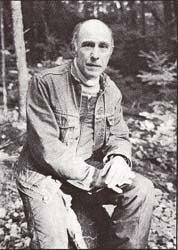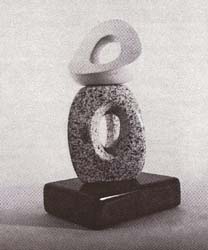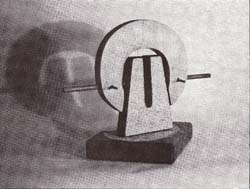This is an interview with sculptor Ivan Neaigus. He has been active on the N.W.S.S.A. exhibit committee and has recently been lstrumental in forming the Sculptors Cooperative Northwest. He lives on Whidbey Island, Wa. where he has his home and tudio. We toured the grounds, viewing several of his sculptures displayed in the yard around his home against a backdrop of !lick woods. His studio includes a woodcarving and woodworking shop, an outdoor covered stone carving area set up for ,neumatic carving, grinding and polishing, and an extensive covered storage area for chunks of tree trunks and stone. We started with his indoor studio and woodcarving area.
IN: This is a carving in iron wood I've got going. I found this at a mine near Palm Desert, California. The wood is extremely hard, so I'm carving it with pneumatic wood chisels, then smoothing it out with this wood-cutting blade for the 4" grinder. It has the motion, but its going to be an abstract of some kind.
SS: Do you work on lour wood pieces more in the winter?
IN: Yes, I can work indoors and stay closer to the fire; in addition, even though it's winter, I also have several stone pieces going.
SS: How do you conceptualize your pieces? Do you make models?
IN.: Normally, I get pieces that already have a shape; nature has given you a head start. I try to flow with that shape and put in my part. When I receive a piece of material, I am interested in what it is, however it got there. Like this piece, for example (looking at a large "y" shaped tree trunk) I see two images of some kind. I'll strip the bark, look at it for a while, then get ready to make the plunge.
With wood it could be a chainsaw plunge-cut; with stone it could be with a cutting wheel, and from there, away you go.
SS: So, you started sculpting in wood?
IN.: Yes, I started with a small chisel set, carving small pieces on the dining room table. That was twelve years ago. I'd been working in corporate America. I reached a point that I wanted to do something else and I wanted to move out of L.A. after being there twenty years. At that time I met my wife Sarah (also an artist in watercolor, photography, and stone mosaic). We decided to explore. I had an artist friend here so we came up and realized "this is it". So, I left my job at that time--I'd had my fill of it. This was with a textile business. I managed the west coast office, selling to manufacturers. Before that I had a career as a designer-merchandiser of men's wear. I did lots of traveling. We imported from Europe and manufactured in Yugoslavia. I would travel to Italy to buy designs and bring them to New York and get them converted to various fabrics.
SS: So, that was your "high stress" phase?
IN: Actually I fmd doing what I'm doing now to be more high stress: trying to fmd your way in something which seems so nonHow do you make art and sell it and make a living like everybody else? There seem to be very few people who actually do that. There's always a secondary income. I'm at the point now where I have a body of work. I am working consistently enough, so hopefully, in time, that will allow me to be a professional. It's a selfcommitment.
SS: What is your unique approach to creating sculpture?
IN: As David Smith said, you must have material around you. Without it nothing happens. And tools... I've set up my situation here so that there is always material to observe. Also in the house and around the yard there are fmished pieces to reflect on. This makes the environment condusive to maintain my commitment to the work. Its got everything I need to continue the process. The unique thing about stone and wood is that as you start working into it, you realize the material has a history. In stone you begin to see things that are ancient. The hardest thing for an artist is finding what resonates with you and how to
express it.

SS: So, what resonates for you?
IN: I'm at a point now, I don't want to convey social messages to the world. I want to make things that have a pleasing shape, a pleasing fmish, a pleasing presence. I realize it isn't possible to change the world with what I do. But, if someone likes my art, and it helps them to enrich their environment, then I've done what I've needed to do. I've gotten it down to a simple way of looking at it. I try to stay with the essence and the beauty of the object and the material. I've stopped doing art as therapy. There's enough negativity in the world, I don't want to add to it. I'd rather add something people will feel good about. For me, abstract form is like a breath of freedom. I'm only dealing with with me and the art, not a lot of other stuff. It's me and the piece and the material.
SS: Where are you now, what direction are you moving in with your art?
IN: I'm dealing with more minimal shapes. I'm doing about 70% of my work in stone and 30% of my pieces in wood. Also, I'm integrating wood with stone. I'm weaving the wood into and out of the stone. I'll be doing more of that kind of thing.
I'll be doing bigger wood pieces for which I'll be buying some lifting equipment. One question I've been asking: "Is bigger better?" (Big being 500 lbs and up) I don't think it is, necessarily. Any size piece can be valuable. (We then inspect a granite piece with purple-heart wood elements which penetrate the stone.) J can see wood has the possibility of highlighting stone. So I'll be doing more pieces along these lines. using the more colorful woods. (We inspect "Sarnadhi", a granite loop form and talk about a basalt piece in progress.)
SS: How often do you work on your pieces?
IN: I come out and do something every day, some long days, some short days.
SS: Which artists do you fmd inspiring?
IN: Henry Moore was the first big inspiration. Then it went on to Nouguchi and Brancusi. Also, Claus Oldenburg, Mark Di Suvero, Christo, Keinholtz, George Seagal, Barbra Hepworth. I am also inspired by artists in the various sculpture publications, and by members of our Association.
SS: With your art do you have a vision you're attempting to achieve?
IN: Initially I look at a piece of stone and J can see it fmished. The vision comes to me as a camera-type thing. I might do a rough sketch to try out a few different approaches. Then I proceed to technically achieve that vision. At the same time, the idea of a set over~all vision seems too much like a wall. It's mostly my starting point. So even though each piece makes its own individual impression, I try 10 keep the vision fluid enough so J can change it. The end goal is the finished piece of sculpture--whether it reflects my initial picture of it or it evolves into something surprising and even more beautiful.

The reason for living is reflected in the idea that at the end of your life you could say "I've done with my life what I wanted to . do". That's the richness that motivates me. It's saying "the heat is on", this moment is precious and important and what I do with it is precious and important. There are times when you are off the track. The trick is to realize that as quickly as possible and to know how to get back "on track". This might be by working or taking a walk or whatever works for you. It's recognizing that this sweetness, this delightfulness, this wonderfulness of life is with you and you're not into a negative outlook. It's hard--as humans we're frail and can become negative. Things like the association and contact with friends help in keeping you afloat. The important thing is being in tune with yourself. Developing a consistent body of work will naturally follow. If you're not in tune with yourself, you will come up against the wall more than you need to.
SS: With abstract work how do you decide the forms you want to work with?
IN: I think it's important to give credence to yourself and the response you have to materials. For instance, while listening to criticism, use it to your advantage. Criticism can sometimes give you a key. I've had some wonderful feed-back from people who are not involved in art. Of course, sometimes it can be painful, but you have to "go with the pain" and take a look at it.
That's why I like to have four or five pieces going at once. If I reach a stalemate with a piece I stop and go on to the next one. Then when I come back to a piece I see it with fresh eyes. The other best critic I have is my wife.
SS: Let's talk about the Sculptors Cooperative Northwest, which you have been instrumental in bringing into being and organizing.
IN: It started with needing to show and sell work. The Association had an exhibiting committee until the tax status changed (requiring a separate organization to be able to sell art), and an opportunity to show at Molbak's garden center in Woodinville opened up. For some reason I was a key person to help bring about this transition. (The Cooperative is now directed by a Board of which Ivan is President.) At the moment all the members of the Cooperative are also members of the Association. So, there's a very close knit group there. It gives the Association another energy input. With the creation of the portfolio of Cooperative members (which will be shown by a sales representative), trying to create shows, and creating workshops in collaboration with the Association, the Cooperative will develop into its own identity. Also there is the opportunity to buy tools and supplies at a discount. One difference will be that the sculptors cooperative is open to anyone doing any kind of sculpture. It will open up to more people of different interests. One year from now we'll know how different that's going to be. Only then will we know how to respond. I want to remind people that it is a Co-op. Although I may be somewhat steering the ship at the moment, we need input from everyone. That's what will make it happen. I appreciate you becoming a member and paying the fee, but your input is as important as joining.

SS: Thanks for all your hard work, Ivan.

